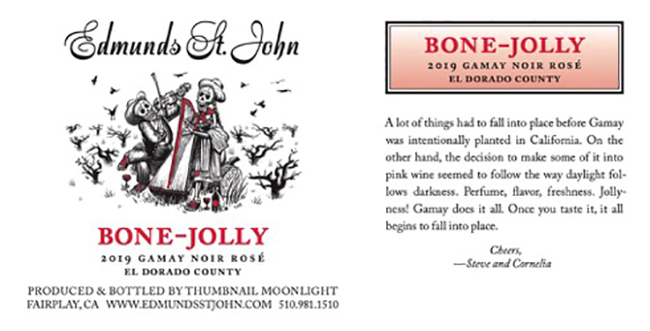
It’s been a long time since we first made rosé from Gamay; the first vintage was 2006. The decision to make rosé from Gamay (we’d previously made rosé from Southern French varieties—Southern Rhone, to be more accurate) came in an epiphanic moment at dinner one night in the Spring that year, sitting across the table from a vintner from Beaujolais who confided in me that he intended to make pink wine that same year, for the first time, from Gamay. There’s a tender-ness to the aromas and textural qualities of Gamay that seems to amplify delicious; and the natural strong acidity of the grape keeps the expressiveness of the wines lifted and high-energy. That combination, it seems to me, almost commands the impulse to make rosé! Still it’s taken almost 15 years accumulated experience of making the wine, and the maturation of the vines during that time, to develop a real groove, to get to feel that I can interact successfully with the raw materials, in a given year, and bring to market a wine that retains to ability to surprise and delight. It feels like it’s gotten to be a kind of devotion practice, by now. Ommmmmmmmm…
Fruit Sources:
Witters Vineyard, at roughly 1,000 meters elevation, is the site of our original planting of Gamay, in red volcanic clay-loam soils, in 2000. Witters seems to give, above all else, perfume and finesse to the wines grown there. At Barsotti Ranch, a few hundred feet lower in elevation, the soil is decomposed granite, and the wines from Barsotti feature, most prominently, firm structure, and intensity, strong underlying backbone.
Winemaking Notes: First pick of the season was at Witters, on September 3rd, all for rosé, a bit over 4 tons. Barsotti Gamay came in three days later, just over 3 and ½ tons. Average Brix: 20.5, pH 3.39. (for me these are great numbers, though picking decision came from the flavor in the grapes) The fruit was all de-stemmed into the press, and pressed out immediately. Fermentation was at roughly 58 degrees Fahrenheit, and lasted 15 days, until the wine was dry. After a small addition of SO2, and an adjustment of temperature, to block malolactic, it stayed on primary lees until December, when it was racked into a clean tank. It was racked again in early March, and filtered and bottled on March 11th, 2020.
Tasting Notes: Electrifying pink color, highlighting blue! Very lively, pretty aromas, and freshness, underlain by a fresh soil-tone (clay?) that’s subtle, yet persistent. Strawberry and plum flavors fan out across the palate, focussed by mouth-watering acidity. Utterly delicious, great length. Cries out for another taste!
Total Production: Under 500 cases
Retail price: $25.00 / bottle